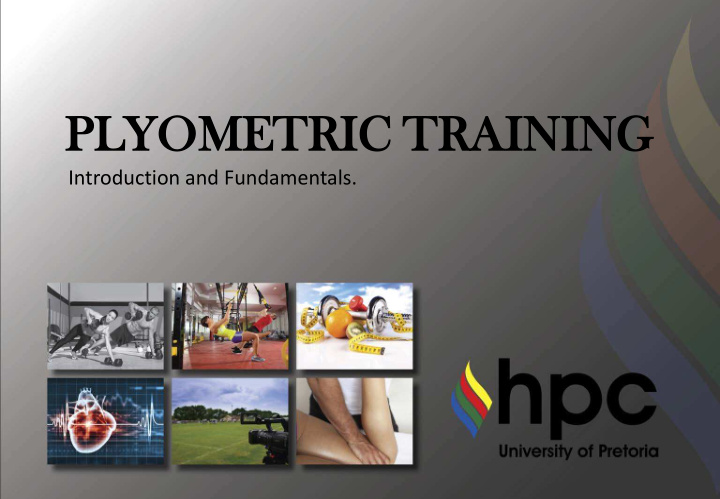



PL PLYOM OMETR TRIC IC TRAIN TRAININ ING G Introduction and Fundamentals.
INTRO WHAT WHERE HOW WHY CONSIDERATIONS
INTRO • HISTORY: • Developed in the 1950’s and 1960’s in Russia, (“Shock Training”). • Progressed to “Plyometrics” , by American Fred Wilt. • Widely used and researched in many sports codes in terms of training methods.
INTRO • GENERAL MUSCULAR MOVEMENTS: • Isotonic, Isometric & Isokinetic • Isotonic: • Length change of the muscle • Concentric muscle action: Shorten • Eccentric Muscle action: Lengthen
INTRO • GENERAL MUSCULAR MOVEMENTS
WHAT Mechanics of plyometrics 1. Eccentric ‘‘stretching’’ of the muscle, 2. is rapidly terminated by a powerful isometric contraction, thus initiating a stretch reflex, where elastic energy is stored. 3. Stored energy increases force in the subsequent concentric action. • Stretch-shortening cycle (SSC), • SSC combines mechanical and neurophysiological mechanisms . • Plyometrics is a means to develop stretch shortening cycle ability.
WHY • Strong Associations with improvements in: • Muscle strength • Muscle power • Bone strength • Balance • Agility • Speed • Resistance to injury • Sports performance • Outlook on physical activity • 4 weeks to see improvement
WHY • Can be used in conjunction with other training to develop explosive quick movements. • Enhanced neuromuscular coordination. • Increase the rate of stretching and shortening of muscle so that the stored elastic energy transfers more rapidly to the next explosive movement.
FYI RESISTANCE VS PLYOMETRIC TRANING • F= ma. • RESISTANCE TRAINING: INCREASE MASS, HIGHER INERTIA • PLYOMETRIC TRAINING: INCREASE IN ACCELERATION AND LOWER INERTIA THERE FOR TARGETING HIGH LEVELS OF CNS STIMULATION AND NEUROMUSCULAR PROCESSES
WHERE • PLYOMETRIC FOCUSED SESSIONS • WARM-UPS: - Neuromuscular Stimulation - Means of “switching on” - Potentiation • COMBINED/COMPLEX TRAINING REGIMES: - More experienced athletes - ie. Resistance training combined with plyometrics - Program design is NB: to achieve greatest benefit.
WHEN • Age ? • Sport ? • Season ? • Periodisation Plan?
PROGRAM DESIGN • MODE • INTENSITY • FREQUENCEY • RECOVERY • VOLUME • PROGRAM LENGTH • PROGRESSION
HOW • Factors to take into consideration when implementing plyometrics. MAGNITUDE AMORTISATION PHASE WARM UP 5-8 GUIDELINE INCREASE S. & A. PRIOR TO H. REST PERIODS
CONSIDERATIONS Plyometric Progression Model
CONSIDERATIONS Tests to establish if an athlete can move to intermediate - advanced plyometrics: • Fully back squat 1.5 times their own body weight • Bench press 1RM should be at least 1.0 – 1.5 times the body weight • Perform five clap push-ups in a row. • Perform 5 reps @60% in 5 seconds • Balance – stand on 1 leg for 30 sec without falling
CONSIDERATIONS Key Points when doing plyometrics • Technique, Technique, Technique!! • Posture and Control • Contact points (hands, feet etc.) • Gradual Progression • Changeover from Eccentric to Concentric Muscle Movement • Rate/ Speed of execution • Be Critical
DISCUSSION TOPICS • CAN WE USE/IMPLEMENT PT IN WRESTLING? AND WHY? • SCHEDULE AND SEASON • HOW CAN WE IMPLEMENT IT IN OUR TRAINING? • PROGRAM DESIGN: WHERE, WHEN, HOW MUCH ETC.? • PRACTICALITY
Conclusion • Increased neuromuscular stimulation • Great method of rapid force development • Quality vs. quantity rule • Innovation and Simplicity • “Not the be all and end all” - Is an effective training method but not should not be done without adequate strength etc. training
References 1. Faigenbaum, A., Myer,G., (2012) Effective Strategies for Developing Young athletes. ACSM Health and Fitness Journal. 16(5) 2. Mirtza, T., Chandlerb,J., Eyersb,C., (2011) The Effects of Physical Activity on the Epiphyseal Growth Plates: A Review of the Literature on Normal Physiology and Clinical Implications. Journal of clinical medical research .3(1) 1-7. 3. Faigenbaum, A., Myer,G., (2012) Effective Strategies for Developing Young athletes. ACSM Health and Fitness Journal. 16(5) 4. Verkhoshansky, Yuri and Mel Cunningham Siff. Supertraining . 1st ed. Rome: Verkhoshansky SSTM, 2009. Print. 5. Baechle, Thomas R and Roger W Earle. Essentials Of Strength Training And Conditioning . 1st ed. Champaign, IL: Human Kinetics, 2008. Print.
Thank You Justin Swan justin.swan@hpc.co.za
Recommend
More recommend